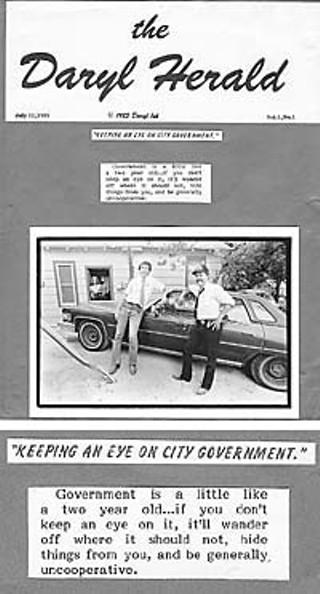The Roots of the Left
From Scholz Garten to 'The Daryl Herald,' four slices of progressive Austin life
By Lauri Apple, Fri., July 4, 2003

Hark! The Herald Daryls Sing
"Government is a little like a 2-year-old ... if you don't keep an eye on it, it'll wander off where it should not, hide things from you, and be generally uncooperative." These words kicked off the debut issue of The Daryl Herald, a spunky political newsletter co-edited on a shoestring by writer Daryl Janes and current Austin City Council Member Daryl Slusher from 1985 to 1987. The Herald's goal, Janes continued, was "to help keep an eye on things" at City Hall, which at the time was occupied by annexations, land development deals, the South Texas Nuclear Project, and the controversial policies of then-City Manager Jorge "Fiasco" Carrasco (deemed by the Daryls as "Carrasconomics").The very first Herald, released July 11, 1985, consisted of a single 11-by-17-inch black-and-white sheet, or four pages when folded in half; by issue No. 4, the paper had doubled its page count. As time passed, the Herald's design transformed from a scrappy, monotonous black-and-white text bonanza into something more elaborate: The paper began experimenting with different fonts, and well-drawn cartoons by Dan Thibodeau added much-needed graphics to break up the humdrum column inches. In the final few months of production, papers came with staples. And for reasons one can only surmise, the number of spelling errors also declined over time.
A year's subscription of the Herald, or 26 issues, cost $25; for a steep $1,000, businesses could become lifetime enrollees -- an unwise investment, given the paper's mayflyish life span. For their investment, readers received coverage of the City Council, municipal issues like the budget ("Let's Get Fiscal," read one title), gossip about then-Travis County Commissioner Bob Honts and other politicos undesirable to the progressive Daryls, and some prodding to invite friends to subscribe. In addition to readers, the Herald also sought correspondents, who were invited to call 44-DARYL and offer their reporting skills on a voluntary basis.
To augment funds generated from subscriptions -- an estimated 300, at their height -- the Herald threw regular fundraisers, the details of which suggest what kind of Weird so many old-timers want Austin to Keep. A flyer for a "meet the editors" barbecue features a photo of the two Daryls at their typewriters, looking somewhat reporterly, Janes wearing a tres-Texas mustache, Slusher's hair reaching past his collar. A subsequent barbecue was catered by folks named Snake and Flossie; the Herald's "Honest Abe-George Washington's Birthday, Can't Tell a Lie" fundraiser featured "swamp music." The Herald also profited, albeit modestly, from ads run by local businesses -- including Florentino's Sandwich & Salad Shop, co-managed by longtime East Austin activists Paul Hernandez and Adela Mancias, who is now Slusher's wife.
The Herald's final, Nov. 26, 1987, edition marked the beginning of the end of the Daryl partnership: "It happened to Martin and Lewis, Simon and Garfunkel, and even [then-Mayor Frank] Cooksey and Carrasco," the two said of their split. Slusher eventually went on to become Politics editor of the Chronicle and then to public office; Janes held a stint at the Austin Business Journal and currently works in the office of state Comptroller Carole Keeton Strayhorn. In 1992, Janes edited No Apologies, a compilation of essays by and about Texas radicals and progressives of the Sixties and Seventies. Stray copies of the Herald ended up at the Austin History Center, where they rest in peace.
Got something to say on the subject? Send a letter to the editor.








